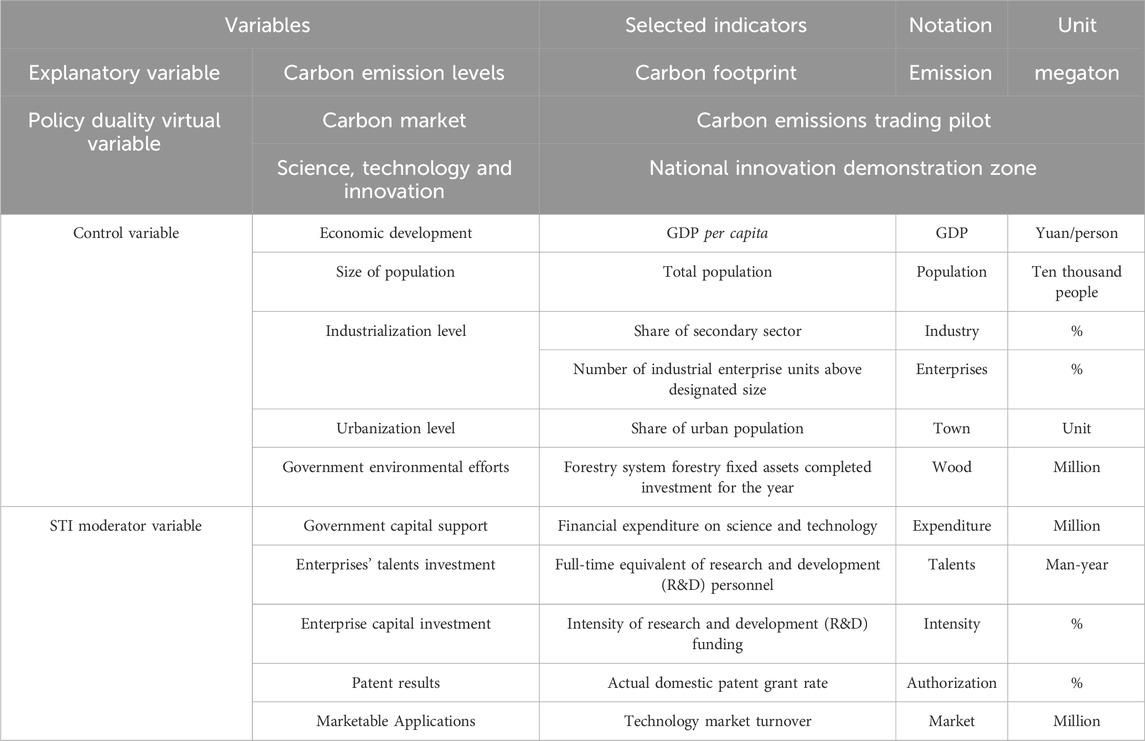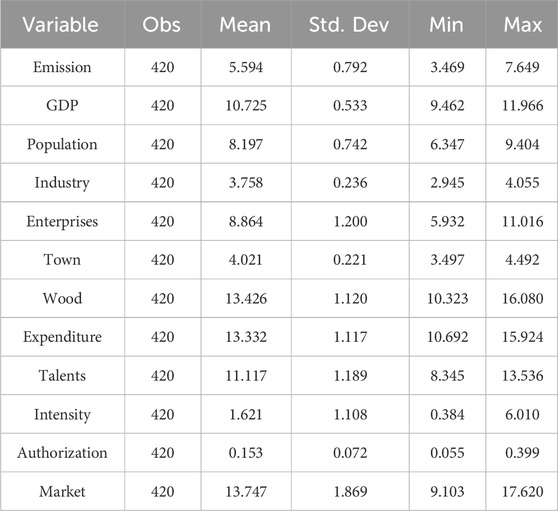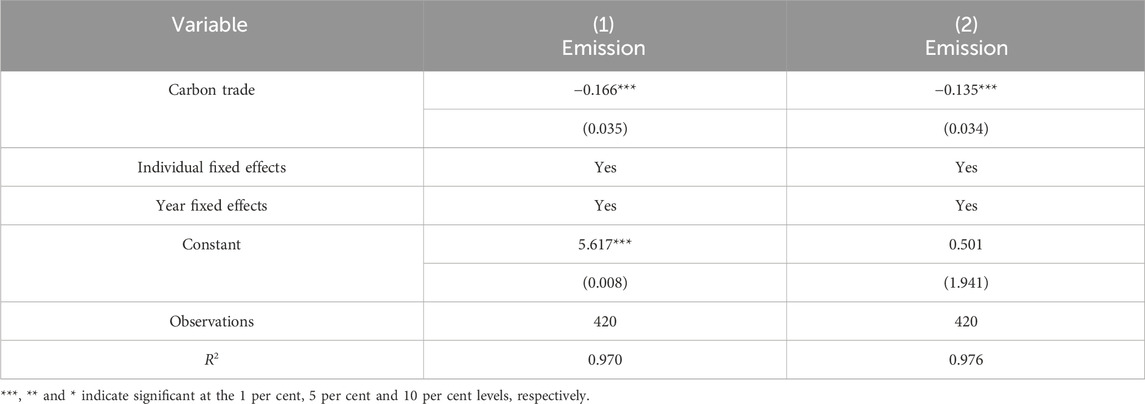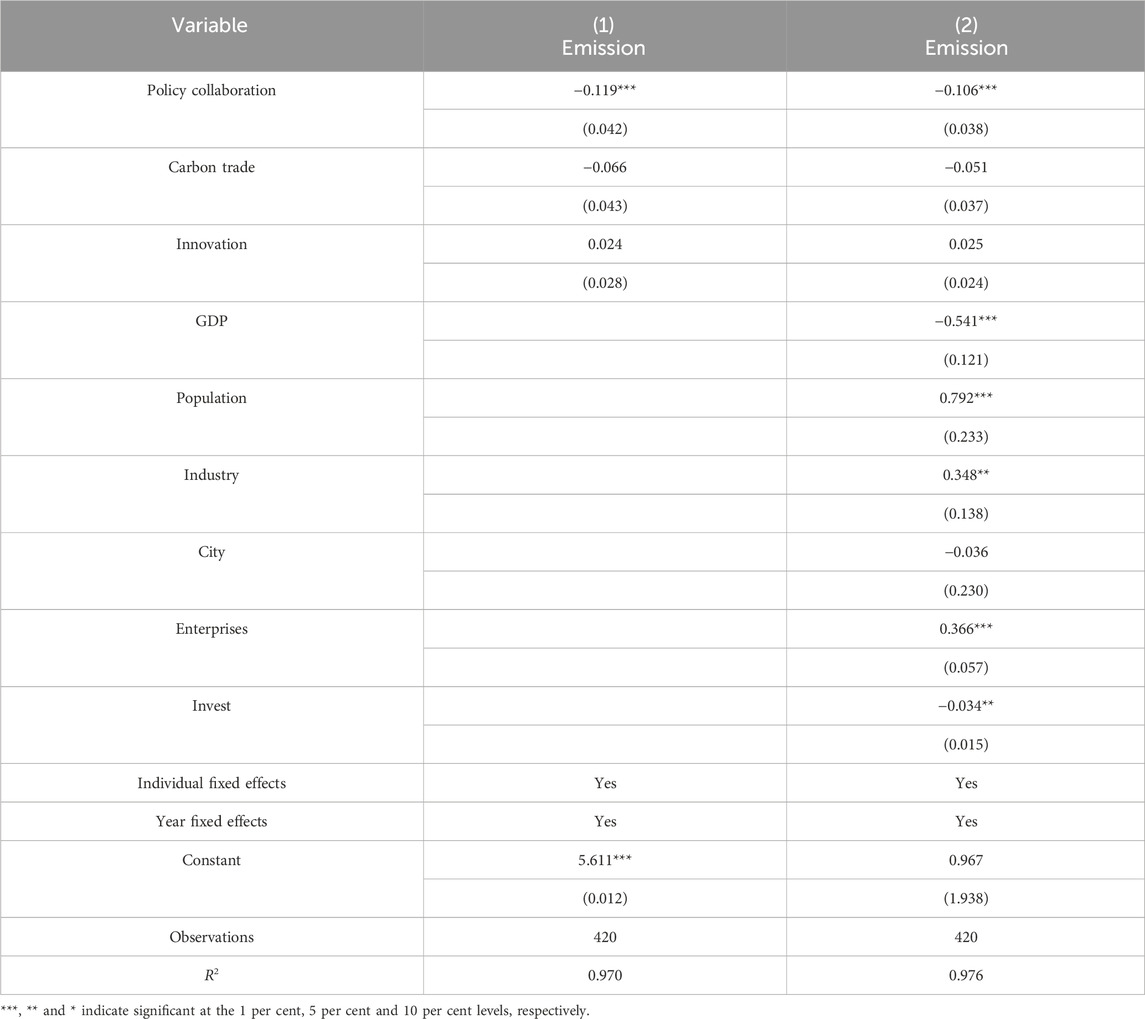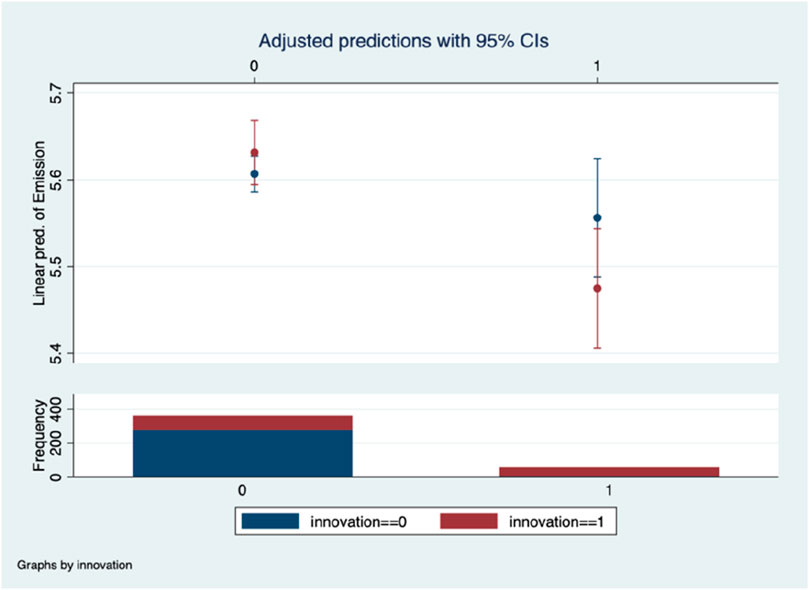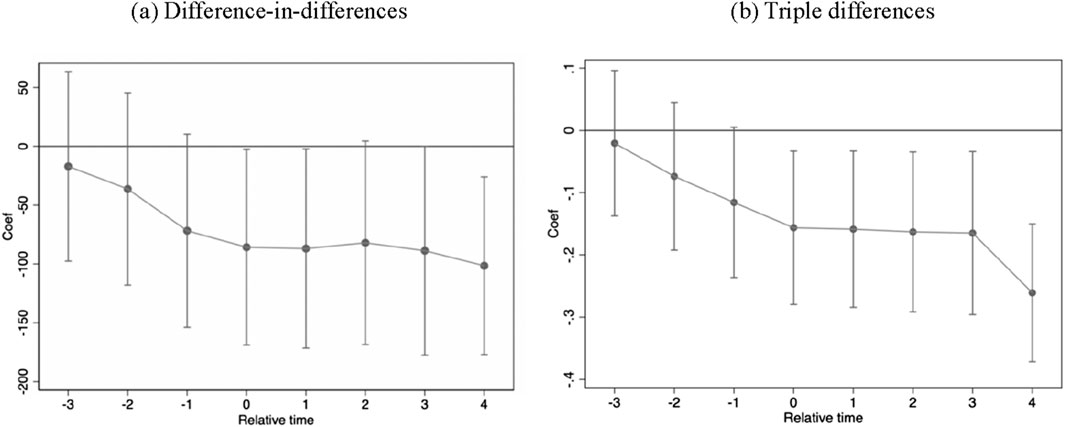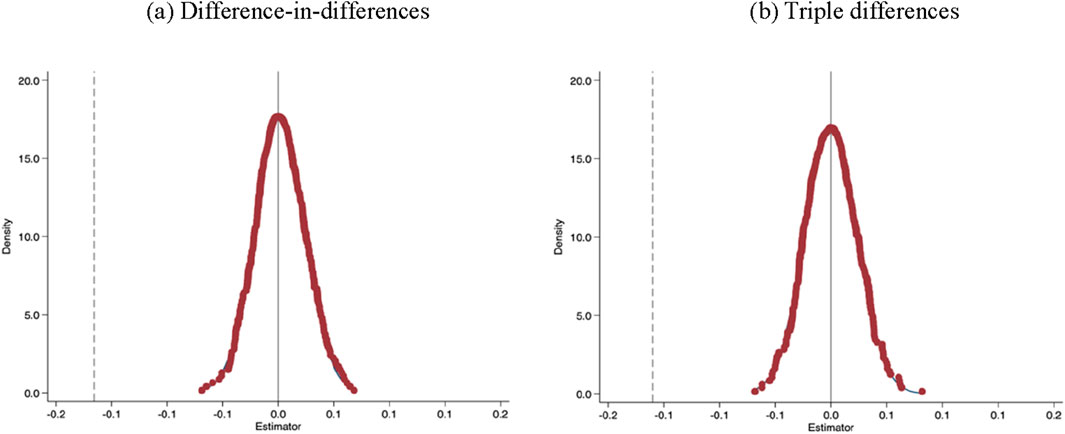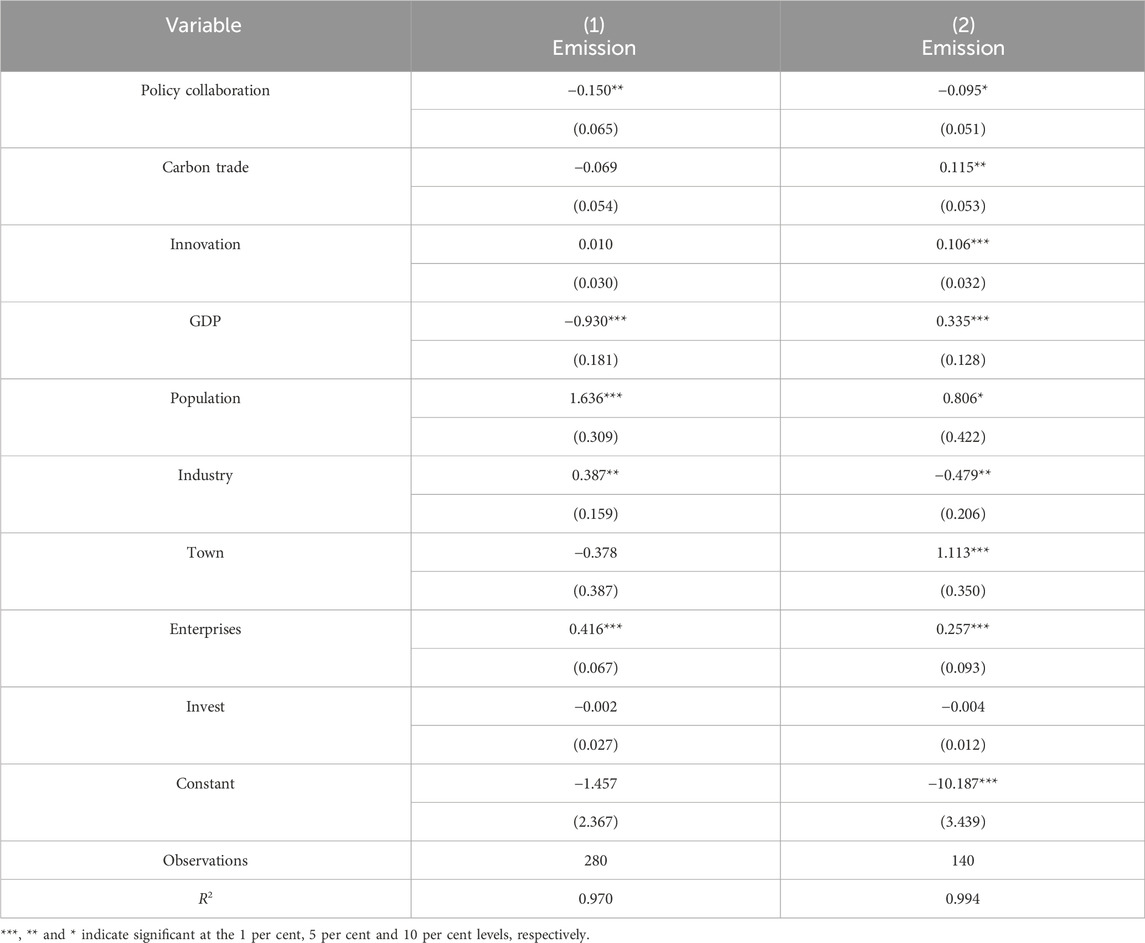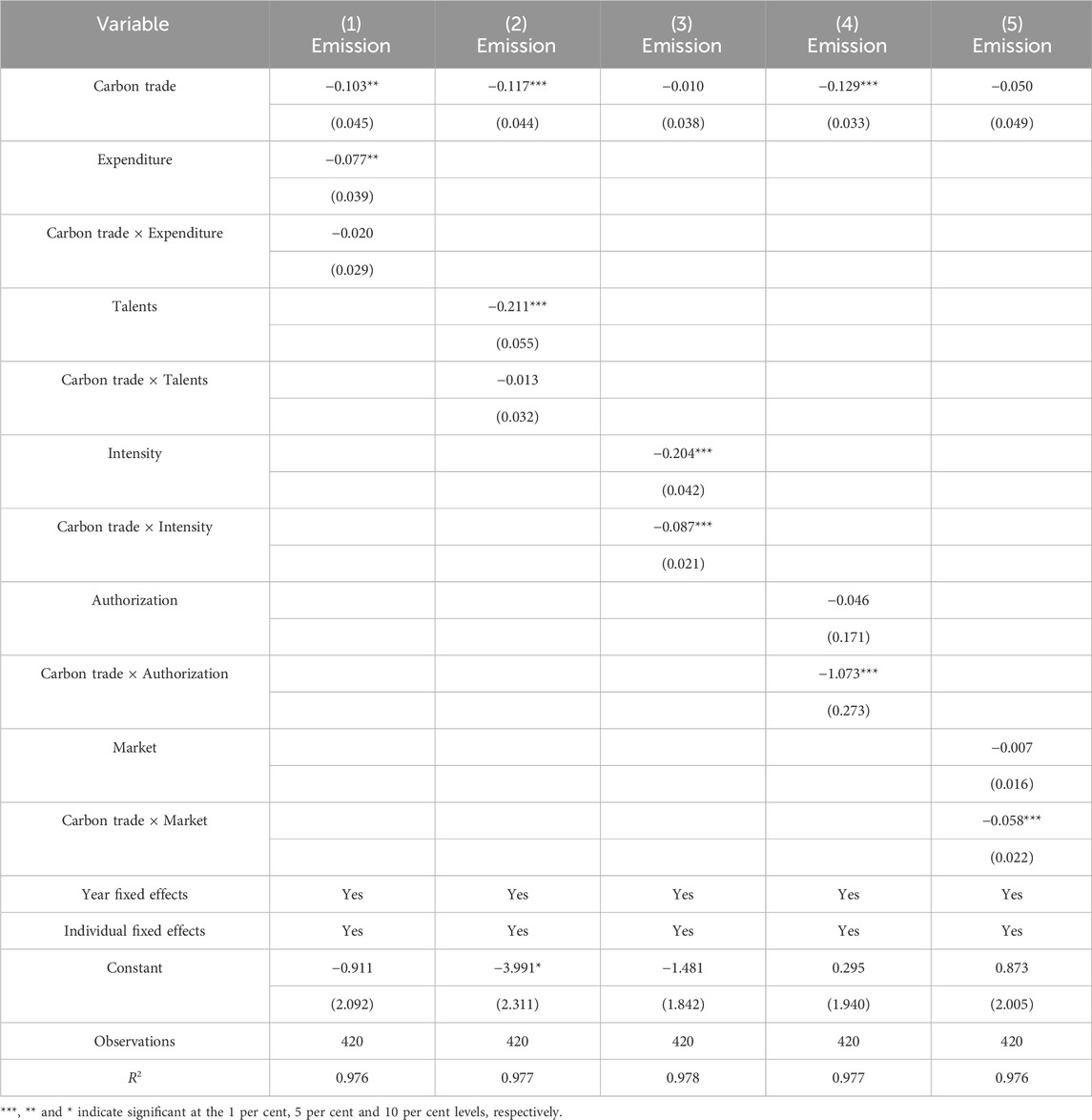- 1School of Economics and Management, North China University of Technology, Beijing, China
- 2China School of Banking and Finance, University of International Business and Economics, Beijing, China
Policy guidance and technological support are important driving forces for accelerating the process of carbon reduction and emission reduction, and the increase in carbon emissions in pilot provinces and municipalities has been reduced year by year since the implementation of the carbon emissions trading pilot in China. It is worth exploring what kind of influence science and technology innovation (STI) has played in this effectiveness. STI is both a macro policy and a micro economic activity. Panel data was collected for 30 provincial administrative units in China from 2008 to 2021, considering the carbon emissions trading pilot as a quasi-natural experiment. Starting from the positive impact of carbon emissions trading policy on emission reduction, we introduce the STI policy of national innovation demonstration zone and use the triple differences model to study the synergistic effect of the two policies. Further, continuous variables related to STI activities are substituted for STI policy, and a moderated test model is constructed to observe the impact of economic activities at different stages of STI on the effect of carbon trading policy. The conclusions of the study show that: (1) The policy of national innovation demonstration zones and the carbon trading policy can synergies with each other to promote emission reduction, and play the effect of 1 + 1>2, which is still robust after the parallel trend test and the individual placebo test; (2) The synergistic effect of the policy in the central and western regions is better than that in the eastern regions, and there is a large space for emission reduction in the future; (3) The positive effect of the carbon trading policy on emission reduction can be effectively amplified by STI activities. Enterprise scientific and technological capital investment, scientific and technological output, and technology marketization play an important role. China should steadily promote the policy of carbon emission right marketization, increase the support for STI activities, improve the incentive mechanism for scientific and technological talents, and continue to promote the marketization of scientific and technological achievements, so as to bring into play the greatest role of STI.
1 Introduction
In response to global climate change, it has become the consensus of more and more countries to build market mechanisms to develop a low-carbon economy and gradually reduce carbon emissions. Since the “dual-carbon” goal was proposed, China has continuously strengthened the top-level design and micro-practice of the carbon market, and the pilot carbon emissions trading scheme started in 2013, which has been gradually extended to the whole country by provinces and cities such as Beijing, Tianjin, Shanghai, Guangdong, etc. In July 2021, China’s carbon emissions trading market will be fully launched, which the carbon emissions rights will be integrated into the national market system as tradable commodities and the world’s largest carbon market was formally established. Apparently, China’s carbon emissions have been under control since 2013, and the growth rate has slowed down, highlighting the effect of the implementation of the carbon trading policy. The control of carbon emissions and the realization of the “dual carbon” goal in the future will depend on the steady improvement of the economic base, the continuous adjustment of the energy and industrial structure, the common environmental awareness of the whole society, and the most crucial thing is technological innovation and application (Wen et al., 2014). Scientific and technological innovation is a major development strategy in China, and the proposal and implementation of this strategy precedes the implementation of carbon trading mechanism. On the one hand, low-carbon, zero-carbon and other related technological innovations can have a direct effect on the control of regional carbon emissions. On the other hand, technological innovations, such as digitization and the internet of Things, can influence the regional energy consumption structure and industrial structure, and indirectly contribute to the reduction of emissions. Therefore, the carbon emissions trading policy and technology innovation strategy are important guarantees for China’s future “dual-carbon” goal.
Scientific assessment of the effectiveness of carbon emissions trading policy is of great significance in guiding future system design and government decision-making. Policy is a catalyst for scientific and technological innovation, and scientific and technological innovation can in turn support the implementation of policy. The carbon emissions trading policy effectively integrates carbon resources on the demand and supply sides and establishes a platform for the exchange of resources (Du et al., 2023). The current carbon market, which does not include the main body of consumers, is able to link the elements between enterprises, forming a cycle of supply and demand for carbon rights between enterprises, and at the same time forcing enterprises with high carbon emissions to carry out technological innovation, so the level of regional scientific and technological innovation has also been strengthened. Under the support of technological innovation, the construction of carbon emissions trading platform and online trading can be realized, and the enthusiasm of regional carbon emissions trading can be improved. It is not difficult to find that there is an interaction between carbon emissions trading policy and technological innovation, so the policy evaluation cannot ignore technological innovation. In the path of carbon emissions trading policy to promote carbon reduction, can science and technology innovation play an enhanced effect? Do science and technology innovation strategies and carbon emissions trading policy work together effectively? What specific indicators play a key role in the input and transformation of STI? These questions need to be further investigated. The quasi-natural experiment nature of China’s carbon trading pilots since 2013 and the national innovation demonstration zones pilots since 2009 provides a good opportunity to study the role of STI in policy-driven emission reduction.
Reviewing the existing literature, Existing studies have empirically examined the effects of China’s carbon emission trading policy from various perspectives. As a market-based environmental regulation, the policy has not only significantly reduced carbon emission intensity and total emissions in pilot regions (He et al., 2023) but also generated a “double dividend” of emission reduction and industrial upgrading (Li and Lin, 2020; Li et al., 2022; Yu et al., 2023; Liu et al., 2019; Dong and Li, 2020; Liu et al., 2022). Beyond these core effects, the policy has also been found to impact broader socio-economic dimensions, such as enhancing urban resilience (Zhang et al., 2024) and improving regional energy efficiency (Zhang et al., 2021). The policy effects exhibit regional heterogeneity, with notable success in provinces like Guangdong, Tianjin, Hubei, and Chongqing (Li and Lin, 2020; Liu et al., 2019). Spillover effects are also observed in non-pilot regions, particularly in areas with lower industrial output and non-resource-based cities (Zheng and Guo, 2022).
Technological innovation plays a crucial role in carbon emission reduction, though its effectiveness is moderated by policy and regional conditions. Studies based on quasi-natural experiments, such as those involving National Innovation Demonstration Zones, confirm that technological innovation contributes to emission reduction and exhibits spatial spillover effects (Jing, 2023; Lan et al., 2022). Its impact is further influenced by factors such as human capital, fiscal capacity, and informatization levels (Wang et al., 2023; Han et al., 2024). Additional pathways include industrial structure upgrading, foreign investment, and government support (He et al., 2022; Wang et al., 2017; Huang et al., 2020). Synergistic effects are observed when innovation city policies are combined with innovation zones (Han et al., 2024). Quantitative studies highlight the importance of both conventional and breakthrough technologies in achieving carbon neutrality (He et al., 2022), while remote sensing data corroborate the positive role of technological advancement in reducing emissions (Wang et al., 2017). However, fiscal vertical imbalance can undermine innovation’s emission reduction effects (Ha and Zhou, 2023). Furthermore, green technology and IoT applications in agriculture are shown to moderate the effects of carbon trading policies (Pang et al., 2024).
It can be seen that carbon emissions trading policy and technological innovation are of great significance to emissions reduction, so what is the impact of the interaction between the policy and the science and technology elements in practice? Along this line of thought, much of the literature has only explored in-depth whether the policy promotes technological innovation in enterprises, and there is no literature to demonstrate the supportive role of technological innovation in the implementation of the policy. Wei and Ren innovatively divide the carbon emission right pilot policy into carbon price signalling and carbon trading, and find that carbon trading can effectively incentivise private enterprises to carry out green technological innovation (Wei and Ren, 2021). The scope of the study further extends to the region, and the carbon emissions trading policy can improve the regional green innovation efficiency by influencing the efficiency of the local government, the depth of the use of digital finance, and the level of local fiscal decentralization in three paths (Xiao et al., 2022). Based on the enterprises’ green invention patent application quantity, Ma et al. found that the pilot policy on the eastern cities and high carbon emission industry enterprise technological innovation effect is particularly obvious (Ma et al., 2021). In order to more accurately explore the impact of dual-carbon goal on technological innovation, Zhang et al. focus on industries and find that there is heterogeneity in the impact of policies on enterprises’ low-carbon technological innovation: the innovation level of electric power and aviation enterprises has been significantly improved (Zhang et al., 2020). Dividing enterprises into two categories based on whether they are involved in carbon trading, Zhu et al. find that enterprises participating in carbon trading have significant increases in low-carbon innovation and the direction and speed of innovation were more conducive to low-carbon development (Zhu et al., 2019). It also drove other technological innovations of enterprises in the two categories. However, Chen et al.'s conclusions are different from the above studies, they believe that under the influence of carbon trading policy, enterprises are more willing to reduce output instead of technological innovation, which reduces the proportion of green patent applications (Chen et al., 2021). Bartram et al. also hold a pessimistic attitude towards enterprise technological innovation, they believe that the carbon trading policy will lead to the enterprise transferring pollution sources, and the development of technological innovation and the actual carbon reduction effect of enterprises are not as expected (Bartram et al., 2022). Feng et al. further found that carbon emissions trading policy would inhibit non-green technological innovation (Feng et al., 2017). Chen et al., based on a potential benefit analysis framework, found that when the value of the marginal abatement cost is higher than the price of carbon, there is no incentive for any region to reduce emissions through technological improvements (Chen et al., 2020). This shows, under certain conditions, that the carbon trading policy has a positive effect on the low-carbon technological innovation of participating enterprises, but the impact on technological innovation of non-participating enterprises and non-green technological innovation is debatable, and whether technological innovation in turn can enhance the emission reduction effect of the carbon trading policy is yet to be demonstrated.
While both carbon trading policies and technological innovation contribute significantly to emission reduction, their interaction remains underexplored. Most literature focuses on the unidirectional impact of the policy on corporate innovation. For instance, carbon trading has been found to stimulate green innovation in private enterprises (Wei and Ren, 2021), with more pronounced effects in eastern regions and high-carbon industries (Ma et al., 2021). Sectors such as power and aviation show active low-carbon innovation (Zhang et al., 2020), and participating firms exhibit higher levels of low-carbon patent applications (Zhu et al., 2019). However, some studies present contrasting views, suggesting that firms may reduce output rather than innovate (Chen et al., 2021), relocate pollution (Bartram et al., 2022), or even reduce non-green innovation (Feng et al., 2017). Cost-benefit analyses also indicate that high marginal abatement costs may weaken incentives for technological upgrading (Chen et al., 2020).
In summary, although the individual roles of carbon trading and technological innovation in emission reduction are well-established, their synergistic relationship lacks in-depth investigation. Most studies focus on single-policy or single-technology pathways, leaving a gap in understanding how technological innovation enhances carbon trading policy effects.
To address this, our study introduces the National Innovation Demonstration Zone policy as an institutional proxy for technological innovation. We employ a triple difference model to identify the synergistic emission reduction effects of carbon trading and innovation policies. We further construct continuous indicators to represent different stages of technological innovation, replacing binary policy variables, to examine their moderating role (Balli and Sørensen, 2013). Finally, we analyze the interaction between policy and technology using marginal effect plots, providing actionable insights for regional emission reduction strategies.
2 Analysis of the mechanism of science and technology innovation to enhance the effect of carbon emissions trading policy
Pilot carbon emissions trading and pilot national innovation demonstration zones are both powerful policy tools for achieving quality and quantity control of carbon emissions. The advancement of regional industrialization and urbanization will lead to an increase in carbon emissions, which in turn generates negative environmental externalities. The carbon emissions trading policy is based on the Coase Theorem, and on the basis of clear property rights, carbon emissions rights are incorporated into the market system as a necessity for emission enterprises, so as to reduce the negative externalities generated by carbon emissions through market behaviour. The government issues a certain number of initial carbon quotas to the sewage enterprises, and the enterprises with less sewage demand obtain additional economic benefits by selling carbon quotas, while the enterprises with more sewage demand buy carbon quotas from the low sewage enterprises to obtain production permits. The marketization of carbon emission rights prompts the high sewage enterprises to change the energy consumption structure and actively carry out technological innovation in pursuit of green transformation through the path of cost, and ultimately achieves the goal of lowering the overall carbon emissions of the region. The reduction of regional carbon emissions is not only guided by the carbon emissions trading policy, but also requires strong scientific and technological support. The application of breakthrough low-carbon technologies has a direct role in reducing emissions, while other technological innovations, such as digitization, can strongly support the construction of carbon trading platforms and indirectly play a role in controlling carbon emissions. China started to set up national innovation demonstration zones in batches in some provinces in 2009, which can serve the high-emission enterprises by improving the policy mechanism and system, gathering funds, talents and other kinds of innovation elements, providing a science and technology financial platform, guiding the in-depth cooperation between industries, universities and research institutes. On the other hand, the national innovation demonstration zones play a role of policy guidance and incentives to attract high-quality and high-tech enterprises to settle in the area, which improve the degree of industrial aggregation and promote the transformation of regional energy and industrial structure through the spillover effect of technology, thus empowering low-carbon development. Some scholars have empirically found that national innovation demonstration zones can significantly reduce regional carbon emissions. This shows that carbon emissions trading policy and science and technology innovation policy can both effectively reduce regional carbon emissions.
In the practice of promoting the two pilot policies, there is bound to be interaction between the policies. Compared with the emission reduction effect of a single policy, the synergy of the two policies can produce better results, and science and technology innovation plays an important supporting role. In essence, carbon emissions trading pilot and national innovation demonstration zones are national policies, the former gives enterprises the right to trade carbon quotas independently, affecting the revenue or cost of sewage enterprises; the latter gathers innovation elements and efficiently carries out technological innovation to provide impetus for the development of enterprises. Two policies make joint efforts to promote emission reduction of enterprises by forcing them to transform and diffuse technology to realize the policy effect of 1 + 1>2. In addition, the efficient implementation of scientific and technological innovation activities in the National Innovation Demonstration Zone can also strongly guarantee the construction of the online platform for carbon emissions trading. Under the trend of digitization and intelligence, the carbon emission right trading of enterprises tends to be online trading, and the technical support can effectively reduce the cost of enterprises’ off-site trading, improve the overall trading efficiency, and provide guarantee for the transparency, security and data detection of the trading. Based on the above analysis, hypothesis 1 is proposed: carbon emissions trading policy and national innovation demonstration zone policy can synergistically promote the reduction of carbon emissions, and STI policy can significantly enhance the effect of carbon trading policy.
STI is both a macroeconomic policy and a microeconomic activity. In terms of the various stages of science and technology innovation, it mainly covers three stages: science and technology input, science and technology output and transformation of scientific and technological achievements. The elements of science and technology inputs include capital inputs and human inputs, i.e., R&D funds and R&D personnel; science and technology outputs are expressed in science and technology results, i.e., papers, patents, etc.; and the transformation of science and technology results is expressed in the application of the technology and the ability to be transformed in the market. Science and technology innovation is a continuous long-term process, from the input and output of science and technology innovation to the final realization of the transformation of results and market application, the enterprise is the main body of innovation. In the input stage of science and technology, the government will make financial allocations and policy support, and the enterprises themselves will invest their own funds and talents to carry out scientific and technological innovation activities; in the output stage of science and technology, the enterprises, through effective management and incentives, will transform the capital and human resources into scientific and technological achievements; in the stage of scientific and technological achievements transformation, the invisible hand of the market will promote the scientific and technological achievements to realize the trading. Decomposing the impact of each stage of science and technology innovation on the emission reduction effect of carbon emissions trading policy, the cost of purchasing carbon allowances is higher for high-emission enterprises, so the investment of scientific and technological capital and manpower can push enterprises to research and develop new technologies to accelerate green transformation. Scientific and technological achievements can be applied to the production activities of high-emission enterprises, directly reducing carbon emissions, lowering the cost of purchasing carbon allowances and improving corporate earnings. The market transformation of scientific and technological achievements accelerates the speed of industry transformation by speeding up the flow of technology and improving the efficiency of technology trading, eliminating enterprises with outdated technology and high carbon emissions. Carbon emissions trading policy guides the development direction of enterprises, and scientific and technological innovation activities can support the transformation and upgrading of enterprises and accelerate the elimination of backward enterprises, and ultimately achieve the goal of reducing carbon emissions. However, in these three stages, there is a risk of waste of resources and inefficient use of scientific and technological inputs, and there is a risk of failure of authorization and market transaction of scientific and technological achievements. While in the stage of transformation of the achievements, the technology achieves market realization, which means that the technology is applied to production, and it can play a role in conjunction with the carbon trading policy to a greater extent, then promote the reduction of carbon emissions. Therefore, hypothesis 2 is proposed: activities in all stages of science and technology innovation can provide strong support for the implementation of carbon emissions trading policy and effectively enhance the effect of emission reduction, among which the transformation of scientific and technological achievements has the greatest positive impact.
3 Empirical study on the enhancement of carbon emissions trading policy effect by science and technology innovation
In order to explore the synergy between science and technology innovation policy and carbon emissions trading policy, in the context of China’s gradual trial implementation of carbon emissions trading policies in three batches in seven provinces and municipalities, namely, Beijing, Tianjin, Guangdong, Shanghai, Hubei, Chongqing, and Fujian, which started in 2013, we treat the carbon emissions trading pilot as a quasi-natural experiment, and firstly use a multi-temporal difference-in-differences model to evaluate the effect of the implementation of the independent policy. On this basis, the national innovation demonstration zones are introduced to portray the science and technology innovation policy. Based on the policy background that 21 provinces such as Beijing, Hubei and other provinces have successively set up national innovation demonstration zones since 2009, the triple differences model is used to study the effect of the control of carbon emissions under the synergistic effect of two policies. The effect of the independent policy will be compared with the effect of the independent policy. The marginal effect is also observed with the help of marginal analysis diagram.
3.1 Sample selection and data sources
The study takes 30 provincial administrative units in China as the research object, excluding the sample of Tibet, and selects the panel data from 2008-2021 to evaluate the effect of carbon emissions trading policy and its synergistic effect with STI policy based on the multi-temporal difference-in-differences model and triple-differences model. All data are from China Carbon Accounting Database (CEADs) and the National Bureau of Statistics (NBS). The explanatory variables are the carbon emission level of each province and city, the core explanatory variables are the policy variables, the control variables were selected with reference to the existing literature, including the level of economic development, population, industrialization and urbanization, and the government’s environmental policy, while the moderating variables were selected according to the stages of STI, which are selected as follows. And the explanation of each indicator is shown in Table 1.
1. The explanatory variables are chosen to portray the carbon emission level of 30 provinces and cities, which are logarithmised.
2. The core explanatory variables are policy variables, including a binary dummy variable for carbon emissions trading policy and a binary dummy variable for national innovation demonstration zones.
3. Among the control variables, GDP per capita is used to portray the level of economic development, the total population is used to portray the population size, the proportion of the secondary industry and the number of industrial units above the large-scale industry is used to portray the level of industrialization, the proportion of urban population is used to portray the level of urbanization, and the investment in forest fixed assets of the forestry system completed in the current year is used to portray the government’s environmental protection policy, capturing the scale of fiscal input into ecological conservation. In order to avoid the influence of extreme values, all the above continuous variables are reduced and logarithmised to a uniform scale.
Among the moderating variables, according to the different stages of STI, the input stage of STI is measured by indicators of government financial expenditure on science and technology, enterprise talent and capital investment; the output stage of STI is measured by patent results; the transformation stage of STI is measured by the amount of technology marketed. The data for the three indicators of financial expenditure on science and technology, input of scientific and technological personnel and turnover in the technology market have been logarithmised and reduced.
Table 2 reports the results of the descriptive statistical analysis of the explanatory, control and moderating variables. It is observed that the logarithmic mean of carbon emissions of 30 provinces and cities in China except Tibet is 5.594, the standard deviation is 0.792, and the maximum value is 7.649, which indicates that there is a large difference in the level of carbon emissions in China. That is related to the imbalance of regional economic development, and side by side reflects that there is still much room for emission reduction in the future. For the control variables, due to the existence of regional development differences, China’s provinces and municipalities in the economy, industrialization, urbanization, population and environmental policies in several aspects of the large differences, which indicates that the control variables selected for this study are valid and control the following variables to better ensure the robustness of the regression results. Among the moderating variables, the financial expenditure on science and technology, talent investment and technology market transactions of 30 provinces and cities in China are large, with large differences between provinces. As for the actual patent grant rate, the mean value is only 0.153 and the standard deviation is 0.072, which needs to be improved overall.
3.2 Econometric modelling
The study begins with a quasi-natural experiment using a pilot carbon emissions trading policy to simulate the difference between control and treatment groups in 30 provinces and cities in China over time, eliminating the effects of other confounding factors, and applying difference-in-differences methods to estimate the net effect of the policy on carbon emission levels.The pilot was launched in 2013 in four provinces and cities (Beijing, Tianjin, Shanghai and Guangdong), and was followed by the addition of Hubei and Chongqing to the pilot in 2014, then Fujian joined the pilot at the end of 2017. Since 2013, 2014 and 2018, when the seven provinces and municipalities started to pilot the policy in batches, are taken as the time points. Beijing, Tianjin, Shanghai, Guangdong, Hubei, Chongqing and Fujian are taken as the treatment groups, the multi-temporal difference-in-differences model is constructed as follows:
Model (1) is a multi-temporal difference-in-differences model based on the carbon emissions trading pilot policy, which
After evaluating the effects of the independent implementation of the carbon emissions trading policy on carbon emissions, the science and technology policy of National Innovation Demonstration Zones was introduced to further explore the role of science and technology innovation in the effects of the carbon emissions trading policy. During the sample period, 21 provinces and cities have established national innovation demonstration zones in batches after 2009. The study takes the provinces and municipalities where both policies are being implemented as the treatment group, which is still Beijing, Tianjin, Shanghai, Guangdong, Hubei, Chongqing and Fujian. The year in which both policies are implemented in a particular province or municipality is seen as the time point, the triple differences model is constructed as shown in Equation 2.
Model (2) is a triple differences model based on the pilot carbon emissions trading policy and the national innovation demonstration zone policy. The
3.3 Benchmark regression results
Table 3 reports the results of the regression of model (1) on the impact of the implementation of a single carbon trading policy on carbon emissions. Columns (1) and (2) report the positive impacts of carbon trading policy on carbon emission reductions. With the inclusion of control variables, each unit enhancement in policy implementation is able to significantly reduce carbon emissions by
Table 4 reports the regression results of model (2), i.e., the impact of the synergy between carbon emissions trading policy and STI policy on the level of carbon emissions. Policy collaboration in columns (1) and (2) is the core coefficient of interest, indicating that there is a strong controlling effect on carbon emissions when two policies simultaneously implemented. After controlling for economic, demographic, and other differences, each unit of enhanced policy collaboration reduces carbon emissions by
Carbon trade and innovation indicate the impact of the implementation of only one policy on carbon emissions, respectively. It can be seen that the establishment of national innovation demonstration zones did not reduce carbon emissions, but through the synergistic effect of the two policies, there is a significant decrease in carbon emissions. This shows that the interaction between STI policy and carbon trading policy can significantly promote emission reduction, and the two together achieve the goal of 1 + 1>2, which also reflects the enhanced role of science and technology innovation in promoting emission reduction by carbon trading policy.
3.4 Marginal analysis of policy synergies
The core regression coefficients reported in the above regression results, which test the positive impact of the interaction of the two policies on emission reductions, but it is not possible to test the marginal effect of a single policy on emission reductions in this impact, so the marginal effect of the carbon emissions trading policy is further analyzed.
Figure 1 reports the marginal effects of the carbon emissions trading policy, with the blue areas indicating provinces and cities that do not have national innovation demonstration zones, and the red areas indicating provinces and cities that have national innovation demonstration zones. The short blue line indicates the significant interval of the marginal effect on emission reduction in provinces and cities without carbon trading policy, and the short red line indicates the significant interval of the marginal effect on emission reduction in provinces and cities with carbon trading policy. From the figure, it can be seen that in the provinces and cities with national innovation demonstration zones, the emission reduction effect is better for the individuals who implement the carbon trading policy, and their carbon emission level is significantly lower than that of the individuals who do not implement the carbon trading policy, which indicates that the science and technology innovation policy effectively amplifies the effect of the carbon trading policy on the emission reduction.
According to the background of the policy implementation, it is found that the provinces and cities without national innovation demonstration zones have not implemented the carbon emissions trading policy at the same time, and it is found that there is no significant difference in the level of carbon emissions by observing the marginal effect on the left side of the figure, which indicates that the synergistic effect of the policy is significant. In summary, it can be concluded that: (1) the science and technology innovation policy can amplify the positive impact of the carbon emissions trading policy on emission reduction, which has a significant supporting effect; (2) the synergistic effect of the two policies on emission reduction is significant.
3.5 Robustness tests
Robustness tests were conducted from time and individual to ensure the robustness of the regression results. The parallel trend test was used in time to test whether there was a significant difference between the treatment and control groups before the policy was implemented, and the placebo test was used in individual to randomly select the treatment and control groups to test the effect of counterfactual policy implementation.
3.5.1 Parallel trend test
Before the implementation of the policy, the carbon emission trend of the samples of the experimental group and the control group should be a parallel trend, and whether the sample data satisfy the assumption of parallel trend is a prerequisite for guaranteeing that the estimation results of the above model have good precision and unbiased consistency. The test results of the difference-in-differences model and triple-differences model are shown in Figure 2. Figure 2a shows the results of the parallel trend test based on the carbon emissions trading policy. Before the implementation of the carbon emissions trading policy, the level of carbon emissions fluctuated around the value of 0, and the estimated coefficients were not significant at the significance level of 10%, which indicated that before the implementation of the policy, there was no significant difference between the carbon emissions of the treatment group and the control group, so the parallel trend test was passed. In the policy implementation period carbon emissions produce a significant effect, and with the increase in the time of policy implementation, in the fourth period carbon emissions appear to further decline.
Figure 2b shows the results of the parallel trend test based on the two policies of carbon emissions trading and the national innovation demonstration zone, with 2013, the year in which the two policies first intersected during the implementation period, set as the period of synergistic implementation of the policies. The results show that the estimated coefficients of carbon emission levels are not significant at the 10% significance level before the two policies interact, which indicates that there is no significant difference between the carbon emissions of the treatment group and the control group before the interaction between the policies, so the parallel trend test is passed. While carbon emissions decreased significantly during the period of policy interaction, and the reduction effect increased further with the increase in policy implementation time.
3.5.2 Individual placebo test
In order to further test the reliability of the regression results, the following randomly select experimental group and control group, conduct a counterfactual individual placebo test, the test results are shown in Figure 3. Figure 3a shows the results of the placebo test based on the carbon emissions trading policy, with seven provinces and cities randomly selected as the experimental group and the remaining provinces and cities as the control group. After 500 samplings, according to the distribution of the coefficient value of the counterfactual policy implementation effect, the random sampling coefficient shows a normal distribution with 0 as the mean, and there is no sampling coefficient located on the right side of −0.17. The placebo test is established, that is, there is no policy effect in the randomly selected experimental group and the control group.
Figure 3b shows the results of the placebo test based on the synergistic terms of the two policies of carbon emissions trading and the national innovation demonstration zone, with seven provinces and cities randomly selected as the experimental group and the remaining provinces and cities as the control group. After the same 500 samplings, it can be seen from the figure that the values of the coefficients of the counterfactual implementation effects are all normally distributed around the value of 0, and there is not a single sampling coefficient located on the right-hand side of −0.16, where the placebo test holds. This suggests that there are no policy effects in the randomly selected experimental and control groups under either a single policy or a quasi-experiment with two policies in concert. The conclusions of the baseline regression analysis are reliable.
3.6 Heterogeneity test
From the statistical analysis of control variables, China as a whole has the situation of unbalanced development among regions, which is reflected in the level of economic development, the level of industrialization and urbanization, and the size of population. In order to further analyse the synergistic effect of different regional policies and observe the supporting role played by science and technology innovation, the following 30 provinces and cities are divided into eastern and central-western regions according to the national regional division standard. The heterogeneity test is conducted based on model (2), and the regression results are shown in the Table 5:
Column (1) reports the regression results for the central and western regions, while column (2) reports the regression results for the eastern region. Policy collaboration is the core coefficient of interest, which indicates the impact of policy synergy on carbon emissions, while Carbon trade and innovation indicate the impact of the implementation of a single policy on carbon emissions, respectively. The results show that two policies working together can effectively reduce carbon emissions in both eastern and central-western regions. However, the synergistic effect of the policies in the central and western regions is better than that in the eastern region, for every unit of policy synergy, carbon emissions can be reduced by
4 Examination of the moderating role of science and technology innovation
4.1 Modelling
In the previous section, the positive effects of carbon emissions trading policy and its synergy with science and technology innovation policy on the control of regional carbon emissions were investigated with the help of difference-in-differences and triple-differences models, and the conclusion was drawn that science and technology innovation can support and enhance the effect of the implementation of carbon emissions trading policy. In order to explore which stage and corresponding indicators play a key role in science and technology innovation, the following is based on model (1) and introduces adjustment variables and constructs a difference-in-differences model with adjustment variables. The explanatory variables and control variables are consistent with the above. The model is constructed as shown in Equation 3.
Model (3) is a difference-in-differences model based on Equation 1 after introducing adjustment variables, and
In order to make the coefficients more comparable, all the moderating variables were decentred before regression[26]. Decentring is the process of subtracting the mean from each of the variables so that the new data sample has a mean of 0. This process not only reduces the problem of multicollinearity that may exist between the variables in the regression model, but also better explains the results of the regression and clarifies the economic meaning of the regression coefficients when the range of values of the moderating variables does not include zero. Before the continuous variables are decentred, the coefficient indicates the impact of each unit change in carbon emissions trading policy on carbon emissions when the value of the regulating variable is 0. After decentring, it can be concluded that when the value of the regulating variable is the mean value, the impact of each unit change in carbon emissions trading policy on carbon emissions.
4.2 Regulatory mechanism test results
Table 6 shows the regression results of model (3), which reports the impact of the interaction between STI and carbon trading pilot policy on carbon emissions after introducing the moderating terms of the indicators related to STI activities at different stages, i.e., the coefficients of the interaction terms that are the focus. It can be found that the interaction of government financial expenditure on science and technology, enterprise human resource input and policy respectively at different stages of STI activities does not significantly affect carbon emissions, while the interaction of three STI activities, namely, enterprise funding intensity, actual patent grant rate and technology marketization, with policy all positively control carbon emissions at the 1% level.
In terms of the degree of emission reduction, when the intensity of enterprise funding is taken at the mean level, for every unit increase in the policy, the regional carbon emission is reduced by
4.3 Marginal analysis of regulatory effects
Since the results of the above moderation test cannot conclude the impact of policy on emission reduction when STI indicators change, the study further analyses the marginal effects of STI activities or policy on carbon emissions with the help of marginal effect diagrams. Figures 4a–c report the marginal effects of carbon emissions trading policies on carbon emissions as the capital investment of enterprises, patent granting rate and technology marketization level increase respectively. The red solid line represents the marginal value change of pilot provinces and cities on carbon emissions, the blue solid line represents non-pilot provinces and cities, and the red and blue dashed lines indicate the confidence intervals. It can be found that, with the increase of enterprise capital investment, patent authorization rate, the marginal effect of the pilot policy on carbon emissions are negative, while the technology marketization cash amount is less, the impact of the policy on emission reduction is not obvious, with the gradual increase in the amount of technology marketization cash, the negative impact of the policy is gradually revealed.

Figure 4. Marginal effects of carbon trading policy on carbon emissions. (a) Intensity. (b) Authorization. (c) Market.
Schumpeter’s innovation theory and Rogers’ diffusion of innovations theory also reveal the lag effect of technology. Following the emergence of new technologies, their successful commercialization and market penetration are prerequisites for widespread adoption and subsequent impacts. A temporal gap exists between a technology’s inception and its practical application. Consequently, for carbon markets, novel technologies must undergo market validation, trading, and implementation before they can genuinely deliver emission reduction benefits and be integrated into industrial production processes. In practice, a further time lag persists between a technology’s successful trading and its large-scale adoption by enterprises. The emission reduction effects stemming from technological marketization are not occur instantaneously.
Based on the symmetry of the interactions, the study adds the analysis of the marginal effects of STI activities in the context of pilot or non-pilot provinces and cities. Figures 5a–c report the marginal effects of firms’ S&T capital investment, patent granting rate and technology marketization level on carbon emissions in the case of implementing and not implementing carbon trading policy, respectively. The red colour represents individuals who implement the carbon trading policy and the blue colour represents individuals who do not implement the policy. It can be found that under the policy background, the enterprise science and technology capital investment, patent authorization rate and the amount of technology market transaction have significant negative effects on carbon emissions, which indicates that not only science and technology innovation can amplify the positive effect of policy on emission reduction, but also the policy can improve the efficiency of science and technology innovation on emission reduction, i.e., science and technology innovation and policy can regulate each other in terms of their positive effects on emission reduction.

Figure 5. Marginal effects of STI activities on carbon emissions. (a) Intensity. (b) Authorization. (c) Market.
5 Conclusions and recommendations
The implementation of the carbon emissions trading policy has been tested in practice to play a positive role in controlling carbon emissions in pilot provinces and cities, and the commercialization of carbon emissions into market trading can effectively promote the realization of the “double carbon” goal. There is no literature on the impact of science and technology innovation in the mechanism of policy-driven emission reduction, but science and technology, as an important support for emission reduction and the construction of a carbon trading platform, has a self-evident role in this mechanism. An in-depth study on whether STI can interact with carbon emissions trading policy to have a positive effect on emission reduction and amplify the policy effect is of great practical significance for enterprises to improve their STI activities, for the government to improve the policy framework of the carbon market and improve the mechanism of STI. It can also provide empirical evidence for the development of regional low-carbon economy and the realization of the “dual-carbon” goal. The study takes 30 provinces and cities in China as samples from 2008-2021, and obtains the following conclusions and provides relevant suggestions after empirical tests:
5.1 Enhancing policy synergy and regional coordination
The implementation of the carbon emissions trading (CET) policy has been empirically proven to effectively control carbon emissions in pilot provinces and cities. Furthermore, the integration of science and technology innovation significantly amplifies this emission reduction effect.
5.1.1 Strengthen the top-level design of policy coordination.
Given that the synergistic effect of the CET policy and the National Innovation Demonstration Zone policy achieves a “1 + 1>2” outcome, it is recommended to break down administrative barriers and establish inter-departmental coordination mechanisms. Specifically, the allocation of carbon emission quotas could be linked to corporate STI performance. For instance, enterprises that achieve breakthroughs in low-carbon technologies or possess a high number of green patents could receive certain quota incentives or flexibility, thereby directly coupling market mechanisms with innovation incentives.
5.1.2 Implement regionally differentiated policy guidance.
The empirical results indicate that the synergistic emission reduction effect is more pronounced in the central and western regions. Therefore, policy support should betilted towards these regions:
Eastern regions: Focus on leveraging existing advantages to pioneer breakthroughs in core low-carbon technologies and high-value technology commercialization.
Central and Western regions: Actively promote the simultaneous implementation of CET and NIDZ policies, utilizing policy tools to guide the flow of innovative elements such as technology, talent, and capital from the east. Support should be provided to establish regional technology trading markets and green technology achievement transformation platforms tailored to local industrial characteristics, fully unlocking their greater potential for emission reduction.
5.2 Refining the full-chain support system for science and technology innovation
The regulatory mechanism test reveals that enterprise R&D funding intensity, patent grants, and technology market turnover significantly enhance the emission reduction effect of the CET policy, whereas government S&T expenditure and enterprise personnel input did not show a significant impact. This suggests the need for precise improvements across the STI chain:
5.2.1 Optimize the input structure and efficiency of innovation resources.
Government fiscal S&T expenditure should Shift from broad subsidies to targeted, performance-oriented funding. Support should be concentrated in key low-carbon technology areas, and a post-evaluation mechanism should be established to ensure funds are truly channeled into innovative activities and enhance their utilization efficiency.
Enterprises should refine their internal talent incentive systems, linking the assessment and remuneration of S&T personnel more closely to innovation output and emission reduction performance to stimulate endogenous motivation for innovation.
5.2.2 Accelerate the output and market-oriented application of innovation achievements.
Improve patent examination standards for green and low-carbon technologies, streamline the authorization process, and enhance the “gold content” and conversion rate of patents.
Given that the enhancing effect of technology marketization becomes more apparent as transaction volumes increase, efforts should be made to build a unified, standardized, and efficient technology trading service platform. This will reduce transaction costs, accelerate the transformation and application of S&T achievements, and shorten the cycle from R&D to marketization.
In conclusion, achieving the “dual-carbon” goal requires not only the continuous improvement of the carbon market mechanism but also the deep empowerment of STI. By strengthening policy coordination, implementing precise measures tailored to regional contexts and specific innovation stages, and promoting the effective alignment of government and market forces, the positive effects of the CET policy on emission reduction can be maximized.
Data availability statement
Publicly available datasets were analyzed in this study. This data can be found here: https://www.ceads.net.cn/.
Ethics statement
Ethical approval was not required for the study involving humans in accordance with the local legislation and institutional requirements. Written informed consent to participate in this study was not required from the participants or the participants’ legal guardians/next of kin in accordance with the national legislation and the institutional requirements.
Author contributions
ZX: Writing – review and editing. CY: Writing – original draft. LQ: Writing – original draft.
Funding
The author(s) declare that financial support was received for the research and/or publication of this article. This research was funded by National Social Science Foundation (23BJY078), the Beijing Municipal Commission Research plan (9232007), the Natural Science Foundation of Beijing, China (SZ202310009004) the Youth Research Special Project of NCUT (No. 2025NCUTYRSP039) and the Research Initiation Fund Project of the North China University of Technology (No. 110051360002).
Conflict of interest
The authors declare that the research was conducted in the absence of any commercial or financial relationships that could be construed as a potential conflict of interest.
Generative AI statement
The author(s) declare that no Generative AI was used in the creation of this manuscript.
Any alternative text (alt text) provided alongside figures in this article has been generated by Frontiers with the support of artificial intelligence and reasonable efforts have been made to ensure accuracy, including review by the authors wherever possible. If you identify any issues, please contact us.
Publisher’s note
All claims expressed in this article are solely those of the authors and do not necessarily represent those of their affiliated organizations, or those of the publisher, the editors and the reviewers. Any product that may be evaluated in this article, or claim that may be made by its manufacturer, is not guaranteed or endorsed by the publisher.
References
Balli, H. O., and Sørensen, B. E. (2013). Interaction effects in econometrics. Empir. Econ. 45 (1), 583–603. doi:10.1007/s00181-012-0604-2
Bartram, S. M., Hou, K., and Kim, S. (2022). Real effects of climate policy: financial constraints and spillovers. J. Financial Econ. 143 (2), 668–696. doi:10.1016/j.jfineco.2021.06.015
Chen, Z. L., Yuan, X. C., Zhang, X. L., and Cao, Y. F. (2020). How will the Chinese national carbon emissions trading scheme work? The assessment of regional potential gains. Energy Policy 137, 111095. doi:10.1016/j.enpol.2019.111095
Chen, Z., Zhang, X., and Chen, F. (2021). Do carbon emission trading schemes stimulate green innovation in enterprises? Technol. Forecast. Soc. Change 168, 120744. doi:10.1016/j.techfore.2021.120744
Dong, M., and Li, C. (2020). Net carbon emission reduction effects of pilot policies in low-carbon provinces and regions. China Population-Resources Environ. 30 (11), 63–74.
Du, M., Wu, F., Ye, D., Zhao, Y., and Liao, L. (2023). Exploring the effects of energy quota trading policy on carbon emission efficiency: quasi-experimental evidence from China. Energy Econ. 124, 106791. doi:10.1016/j.eneco.2023.106791
Feng, C., Shi, B. B., and Kang, R. (2017). Does environmental policy reduce enterprise Innovation? Evidence from China. Sustainability 9 (6), 872. doi:10.3390/su9060872
Ha, M., and Zhou, T. (2023). The impact of science and technology innovation on carbon emissions under the constraint of fiscal vertical imbalance. Sci. Technol. Prog. Countermeas. 40 (22), 43–52.
Han, X., Zheng, J., and Yin, Y. (2024). Innovation-driven policies, government environmental attention and green high-quality development - evidence from national autonomous innovation demonstration zones[J/OL]. Soft Sci. 1–12. doi:10.13956/j.ss.1001-8409.2024.04.06
He, J. K., Li, Z., Zhang, X. L., Wang, H. L., Du, E. S., Chang, S. Y., et al. (2022). Towards carbon neutrality: a study on China's long-term low-carbon transition pathways and strategies. Environ. Sci. Ecotechnology 9, 100134. doi:10.1016/j.ese.2021.100134
He, M., Zhu, X., and Li, H. (2023). Sci. Total Environ. 858 (P1), 159871. doi:10.1016/j.scitotenv.2022.159871
Huang, S., Wen, Z., Chen, J., and Cui, N. (2020). Optimal technology investment under emission trading policy. J. Syst. Sci. Syst. Eng. 29 (3), 143–162. doi:10.1007/s11518-019-5443-7
Jing, G. (2023). Carbon emission reduction effect of national innovation demonstration zones. China Population-Resources Environ. 33 (06), 23–33.
Lan, F., Heyan, T., and Muge, M. (2022). Innovation-driven development and urban carbon emission reduction: a quasi-natural experiment in China. Environ. Sci. Pollut. Res. Int. 30 (3), 8002–8019. doi:10.1007/s11356-022-22712-7
Li, S., and Lin, P. (2020). Study on the effect of improving carbon emissions trading policy and promoting regional pollution reduction in China--A difference-in-differences analysis based on provincial panel data. J. Sun Yat-sen Univ. Soc. Sci. Ed. 60 (05), 182–194.
Li, Z., Che, S., and Wang, J. (2022). Examination of the implementation effect of carbon emissions trading pilot policy. Statistics Decis. Mak. 38 (18), 166–170. doi:10.13546/j.cnki.tjyjc.2022.18.032
Liu, C., Sun, Z., and Zhang, J. (2019). Research on the carbon emission reduction policy effect of China's carbon emissions trading pilot. China Population-Resources Environ. 29 (11), 49–58.
Liu, W., Qiu, Y., Jia, L., and Zhou, H. (2022). Carbon emissions trading and green technology innovation—A quasi-natural experiment based on a carbon trading market pilot. Int. J. Environ. Res. Public Health 19 (24), 16700. doi:10.3390/ijerph192416700
Ma, J., Hu, Q., Shen, W., and Wei, X. (2021). Does the low-carbon city pilot policy promote green technology innovation? Based on green patent data of Chinese A-share listed companies. based on green patent data of Chinese A-share listed companies. Int. J. Environ. Res. Public Health 18 (7), 3695. doi:10.3390/ijerph18073695
Pang, H. W., Liu, X. Y., Gong, Y. H., and Wang, Z. W. (2024). Internet of things development, science and technology innovation and agricultural carbon emission intensity. Econ. Issues (02), 77–83. (in Chinese). doi:10.16011/j.cnki.jjwt.2024.02.001
Wang, S., Liu, X., Zhou, C., Hu, J., and Ou, J. (2017). Examining the impacts of socioeconomic factors, urban form, and transportation networks on CO2 emissions in China's megacities. Appl. Energy 185, 189–200. doi:10.1016/j.apenergy.2016.10.052
Wang, K., Xu, R., Wei, J., and Liu, Y. (2023). Impact of national industrial relocation demonstration zones (NIRDZs) policy on urban carbon emissions in China. Environ. Impact Assess. Rev. 102, 107165. doi:10.1016/j.eiar.2023.107165
Wei, L., and Ren, L. (2021). Can carbon emission trading promote enterprises' green technology innovation - based on the perspective of carbon price. Lanzhou J. 334 (07), 91–110.
Wen, Z., Zhang, X., Chen, J., and Tan, Q. (2014). Forecasting Co2 mitigation and policy options for China's key sectors in 2010–2030. Energy & Environ. 25 (3-4), 635–659. doi:10.1260/0958-305x.25.3-4.635
Xiao, Z., Tan, R., Shi, J., and Wang, F. (2022). Research on the impact of environmental regulation on regional green innovation efficiency--a quasi-natural experiment based on the pilot project of carbon emission right. Front. Eng. Manag. Sci. Technol. 41 (02), 63–69.
Yu, J., Liu, P., Shi, X., and Ai, X. (2023). China’s emissions trading scheme, firms’ R&D investment and emissions reduction. Econ. Analysis Policy 80, 1021–1037. doi:10.1016/j.eap.2023.09.039
Zhang, Y., Shi, W., and Jiang, L. (2020). Does China's carbon emissions trading policy improve the technology innovation of relevant enterprises? Bus. Strategy Environ. 29 (3), 872–885. doi:10.1002/bse.2404
Zhang, X., Lu, F., and Xue, D. (2021). Does China's carbon emission trading policy improve regional energy efficiency? an analysis based on quasi-experimental and policy spillover effects. Environ. Sci. Pollut. Res. Int. 29 (14), 21166–21183. doi:10.1007/s11356-021-17021-4
Zhang, S., Ma, X., Cui, Q., and Liu, J. (2024). Does the low carbon transition impact urban resilience? Evidence from China's pilot cities for carbon emission trading. Environ. Sci. Pollut. Res. Int. 31 (7), 11128–11149. doi:10.1007/s11356-024-31903-3
Zheng, H., and Guo, L. (2022). External effects of pilot low carbon cities on carbon emissions of neighbouring non-pilot cities. China Population-Resources Environ. 32 (07), 71–80.
Keywords: carbon emissions trading pilot, national innovation demonstration zones, triple differences model, science and technology innovation stage, regulation test
Citation: Xuefeng Z, Yanqi C and Qingyang L (2025) Research on the emission reduction effect of carbon emission trading policy supported by science and technology innovation. Front. Environ. Sci. 13:1724664. doi: 10.3389/fenvs.2025.1724664
Received: 14 October 2025; Accepted: 28 October 2025;
Published: 11 November 2025.
Edited by:
Jian Yu, Central University of Finance and Economics, ChinaReviewed by:
Yongliang Zhang, China University of Mining and Technology, ChinaXiong Kuang, Hainan University, China
Copyright © 2025 Xuefeng, Yanqi and Qingyang. This is an open-access article distributed under the terms of the Creative Commons Attribution License (CC BY). The use, distribution or reproduction in other forums is permitted, provided the original author(s) and the copyright owner(s) are credited and that the original publication in this journal is cited, in accordance with accepted academic practice. No use, distribution or reproduction is permitted which does not comply with these terms.
*Correspondence: Lv Qingyang, eTIxNzU0MjQyOThAMTYzLmNvbQ==
 Zhang Xuefeng1
Zhang Xuefeng1 Cheng Yanqi
Cheng Yanqi Lv Qingyang
Lv Qingyang